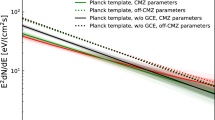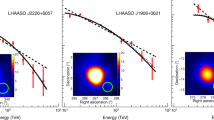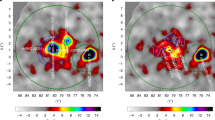Abstract
IT has been suggested1 that the cross-section for star production is proportional to the geometrical cross-section of the nucleus. In order to establish this by direct experiment, we have exposed some 'gelatin sandwich' plates for fifty days at a height of 3,650 m. These plates consist of four layers of Ilford C.2 Nuclear Research emulsion, 30 µ thick, separated by three thin layers of plain gelatin. This sandwich emulsion, coated on an acetate base, was supercoated with a 5µ gelatin layer. A second batch of plates with emulsion layers of 25µ was exposed for forty days. In order to determine the thickness of the gelatin layers (excluding the super-coat) relative to the normal emulsion, we have measured the ratio of the projections in the plane of the emulsion of track length to gap length for those tracks which pass right through the sandwich emulsion. The gaps in the tracks occur when the ionizing particles pass through the gelatin layers. From these measurements on 300 tracks of length greater than 200µ we conclude that in the plates so far examined the mean gelatin thickness : mean emulsion thickness equals 9·2 per cent.
This is a preview of subscription content, access via your institution
Access options
Subscribe to this journal
Receive 51 print issues and online access
$199.00 per year
only $3.90 per issue
Buy this article
- Purchase on Springer Link
- Instant access to full article PDF
Prices may be subject to local taxes which are calculated during checkout
Similar content being viewed by others
Author information
Authors and Affiliations
Rights and permissions
About this article
Cite this article
HARDING, J. Cross-Section for Nuclear Disintegration Produced by Cosmic Rays. Nature 163, 440–441 (1949). https://doi.org/10.1038/163440a0
Issue Date:
DOI: https://doi.org/10.1038/163440a0
This article is cited by
-
Target mass dependence of charged particle multiplicity inp-nucleus interactions
Zeitschrift f�r Physik C Particles and Fields (1981)
-
Meson production on heavy target-nuclei at energies >1011 eV
Il Nuovo Cimento (1962)
-
Scattering measurements in nuclear emulsions and their application to measuring the charge of primary cosmic ray nuclei
Proceedings of the Indian Academy of Sciences - Section A (1955)
-
Sulla distribuzione angolare dei rami delle stelle prodotte dalla radiazione cosmica nelle emulsioni fotografiche
Il Nuovo Cimento (1951)
-
Stelle d'evaporazione generate in lamine metalliche
Il Nuovo Cimento (1951)
Comments
By submitting a comment you agree to abide by our Terms and Community Guidelines. If you find something abusive or that does not comply with our terms or guidelines please flag it as inappropriate.



